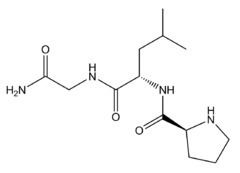MedlinePlus a605038 Bioavailability 100% (injected) CAS Number 2002-44-0 | Routes ofadministration IV Excretion N/A Molar mass 284.355 g/mol | |
 | ||
Metabolism | ||
Melanocyte-inhibiting factor (also known as Pro-Leu-Gly-NH2, Melanostatin, MSH release–inhibiting hormone or MIF-1) is an endogenous peptide fragment derived from cleavage of the hormone oxytocin, but having generally different actions in the body. MIF-1 produces multiple effects, both blocking the effects of opioid receptor activation, while at the same time acting as a positive allosteric modulator of the D2 and D4 dopamine receptor subtypes, as well as inhibiting release of other neuropeptides such as alpha-MSH, and potentiating melatonin activity.
This complex mix of actions produces a profile of antidepressant, nootropic, and anti-Parkinsonian effects when MIF-1 is administered, and it has been investigated for various medical uses. MIF-1 is unusually resistant to metabolism in the bloodstream, and crosses the blood–brain barrier easily, though it is poorly active orally and is usually injected. Several other closely related peptides with important actions in the body include Tyr-MIF-1 and endomorphin-1 and -2.
